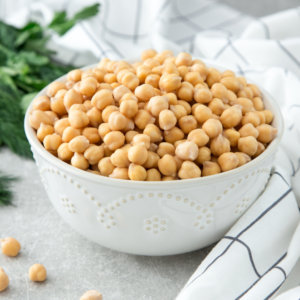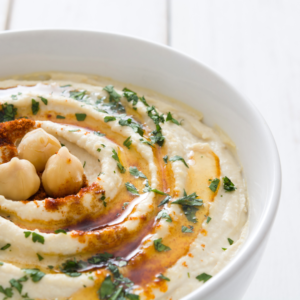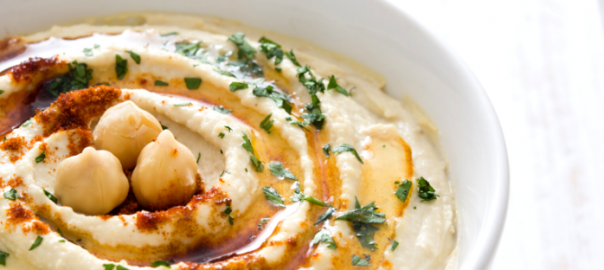One of the easiest and healthiest snacks you can make is hummus. High in protein, fiber, vitamin 6, and manganese, it tends to be served either with pita bread, crackers, or with vegetables. Not only is hummus delicious and high in protein, it has a huge fan following.
There are songs/music videos (this is just one of them), movies, and even culinary competitions, all devoted to this humble condiment.
Originating in the Middle East with the earliest known recipes appearing in the 13th century, hummus has become popular worldwide. Traditionally it’s made from cooked chickpeas which are ground up and then mixed with lemon juice, olive oil, salt, and garlic. Purists also call for the addition of tahini, a sesame seed paste, when making traditional style hummus. It tends to be served as an appetizer or a dip. Sometimes it can also be served as a side dish with things like falafel, grilled chicken or fish, or as part of a meze plate.
Where to get hummus
Want to know where my favorite place to buy hummus is? The best place on the planet to get it (in my humble opinion)? It’s a tiny little out-of-the-way, hole-in-the-wall place in the Old City in Jerusalem called Abu Shukri. I’ve been fortunate enough to eat there twice, both times with my wonderful Aunt Carol.
The first time she took me there, in the mid 1990’s, it was a revelation of how amazing hummus, and the falafel and pitot that accompanied it, could taste. Quite frankly it spoiled me for falafel, hummus, and pita for years. You think I’m kidding, but I’m not. It took a very long time for the memory of that dish to fade to the point that I could eat that again anywhere and not mourn that it wasn’t from Abu Shukri.
The second time was fifteen years later when I went back to Jerusalem. Aunt Carol asked me what was on my list of places to visit. I told her I needed to go back to, “that amazing hummus and falafel place.” I had forgotten the name by then but not the taste. She laughed and said, “Do you mean Abu Shukri?” I said I thought that was it.
So one fine day we made our way to the Old City. After getting lost a couple of times (there’s lots of twisty turns and not well marked alleyways all over the Old City) we eventually found it. To my delight it still looked just as hole-in-the-wall-ish. The intervening years had done nothing for the décor. And their reputation, although still solid, had not encouraged the owners to “fluff it up” and try to make it more appealing to tourists. They have a good thing going and they obviously know it.
The place even smelled just like I remembered (although I didn’t remember that until I smelled it again). I was salivating before we even got to the counter to place our order. We had a lovely lovely meal together, enjoying the food, each other’s company, and delightful conversation.
Sadly Abu Shukri is pretty far from where I live. I plan to get back there again eventually, but for now I remember it fondly and content myself with making my own hummus at home. I’ve actually gotten better at making it over the years. I do wonder if part of the flavor at Abu Shukri has to do with the setting and the company (I’m pretty sure it does).
Buying Hummus
Hummus has become so popular that it’s easily available at the grocery store. There are a number of different companies that make it. It even comes in a wide variety of flavors. On a recent trip to the grocery store I was astounded to see the following varieties of hummus in the refrigerated case. Seriously, they had a whole lined up selection:
- Traditional
- Mediterranean
- Greek Inspired
- Roasted Red Pepper
- Roasted Pine Nut
- Jalapeno
- Siracha
- Sun Dried Tomato
- Caramelized Onion
- Roasted Garlic
- Chocolate
- Sea Salt Caramel
- Cake Batter
- Chickpea Nutty
- Lemon Meringue
I confess I was a little puzzled by the Mediterranean style as I was pretty convinced hummus already was a Mediterranean food, but I guess it’s the spices that make the difference. And I’m really not a fan of the dessert varieties. I confess I did try a chocolate one once (after all…chocolate) but it didn’t really impress me. I have no interest whatsoever in trying the other sweet varieties, probably because I love plain hummus so much that it just doesn’t appeal to me to have it as a dessert.
One of the problems with many commercial varieties is the ingredients. Things like the use of soybean oil instead of olive oil are not a great choice. The olive oil is a healthy monounsaturated fat which is a great source of vitamin E and highly anti-inflammatory.
Soybean oil, on the other hand, is highly genetically modified. Even if the variety used in the hummus you are buying is non-GMO, it’s still probably highly contaminated with glyphosate (sprayed to keep down the weeds), is high in omega-6 fatty acids, and consuming it may, over time, contribute to inflammation.
Another issue with commercially made hummus is the added preservatives. The ones that are most commonly used are citric acid, which may be genetically modified, and potassium sorbate. These are not good choices to have in your foods and I do recommend avoiding them.
Making it at home
Hummus is actually very easy to make at home. There are two strategies for making your own. The first is to seriously start from scratch and begin with dry chickpeas, sometimes called garbanzo beans. Rehydrating chickpeas is not difficult, it just takes a little time. One of the benefits of rehydrating chickpeas is that there are no added preservatives, it’s just the chickpeas. Another benefit is that you can make extra and freeze them. If you’re not into the idea of rehydrating chickpeas you can always use the canned variety.

Rehydrating Chickpeas
Ingredients
- 2 cups dried chickpeas
- 6 cups water
- 1 teaspoon salt
Instructions
- Pick out stones or foreign matter from chickpeas
- Rinse well and drain
- Put into crock-pot with water and salt
- Cook on high 3 hours
- Remove crock from cooking element and pour chickpeas into a colander to drain
- Rinse well
- Chickpeas are now ready to use
Notes

Homemade Hummus
Ingredients
- 2 cups cooked, or canned, chickpeas
- 1/4 cup water or whey
- 2-3 tablespoons lemon juice (depending on your preference)
- 1 1/2 tablespoons tahini
- 2 cloves garlic, crushed
- 1/2 teaspoon salt
- 2 tablespoons olive
- garnish: extra olive oil, paprika, and fresh chopped parsley
Instructions
- Combine chickpeas, water/whey, and lemon juice in a food processor
- Blend together, slowing adding olive oil to the mixture until it starts to stick together
- Add remaining ingredients
- If needed add a little more olive oil to make it smooth
- Spoon hummus into a serving bowl or dish
- Drizzle with olive oil, garnish with a dusting of paprika and a sprinkle of fresh chopped parsley
Other ways to eat hummus
Whether you choose to buy your hummus pre-made (being sure to read the label and avoid negative ingredients) or make it at home, it’s a quick and easy way to add this delicious dish to your diet.
Don’t forget that it can be more than just a snack with pita bread or veggies. Here are a few suggestions for other ways to eat this wonderful dish:
- Use it as a salad dressing - it may need to be thinned just a little with olive oil
- It’s a fabulous marinade - perfect on chicken, let it marinate for 2 hours before grilling
- Instead of mayonnaise - it’s a great way to add flavor to any sandwich or lettuce wrap
- Eggplant roll ups - made with hummus instead of ricotta is a fabulous dairy-free option
- Raw-fredo - instead of using a cream sauce try hummus on your pasta or noodles
- On apples - instead of nut butter and apples, try hummus, you’ll be surprised how good it is
- Condiment - adding a dollop of hummus on top of scrambled eggs is very tasty

